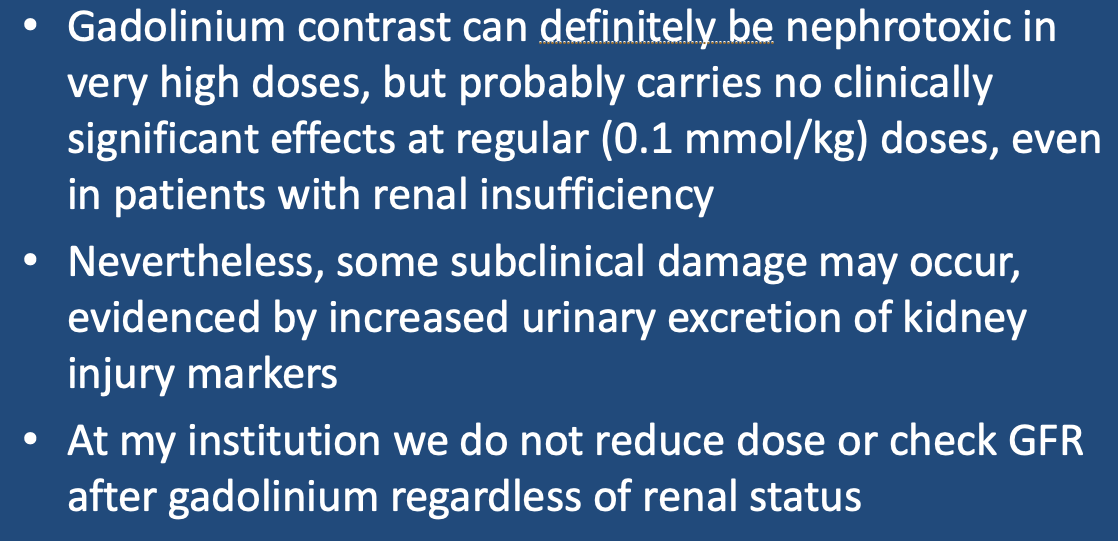Between about 1995 and 2005, high-dose gadolinium contrast was being promoted by some centers as an alternative to iodinated contrast for catheter angiography in patients with renal failure or insufficiency. The required gadolinium doses to achieve adequate x-ray opacification were very high (3-10x normal intravenous doses), and cases of gadolinium-contrast induced nephropathy began to appear. The use gadolinium at any dose level in patients with severe renal disease was ended in the late 2000's due to the recognition of its association with nephrogenic systemic fibrosis.
In high doses gadolinium contrast can therefore definitely be nephrotoxic to patients with pre-existing renal disease. But can patients with either normal or impaired function receive gadolinium in regular (0.1 mmol/kg) dosage without fear of renal damage?
I personally believe the answer is "Yes", but admittedly science has not completely answered this question. The review article by Martino et al summarizes evidence that regular dose gadolinium, given even to patients in moderate to severe renal failure, does not precipitate overt acute kidney injury or changes in serum creatinine. Nevertheless, a number of human and animal studies have demonstrated transient increases in some sensitive urine markers for renal tubular injury (NAG, KIM1, NGAL, IL18) after gadolinium administration. Thus there remains some concern that gadolinium contrast agents in normal doses may cause very subtle renal injury.
Notwithstanding these potential concerns, at my institution we give regular dose Group II gadolinium contrast to virtually all patients with a diagnostic need, regardless of their renal status. Moreover, we do not reduce gadolinium dose or check GFR before or after the exam.
Advanced Discussion (show/hide)»
No supplementary material yet. Check back soon!
References
Erley CM, Bader BD, Berger ED, et al. Gadolinium-based contrast media compared with iodinated media for digital subtraction angiography in azotaemic patients. Nephrol Dial Transplant 2004: 19:2526-2531.
Elmstahl B, Leander P, Grant D, et al. Histomorphological changes after renal X-ray arteriography using iodine and gadolinium contrast media in an ischemic porcine model. Acta Radiol 2007;23:1–11.
Ergün I, Keven K, Uruç I, et al. The safety of gadolinium in patients with stage 3 and 4 renal failure. Nephrol Dial Transplant 2006; 21:697-700. (12% of such patients receiving double dose - 0.02 mmol/kg - gadolinium developed acute renal failure)
Mawad H, Laurin L-P, Naud J-F, et al. Changes in urinary and serum levels of novel biomarkers after administration of gadolinium-based contrast agents. Biomarker Insights 2016; 11:91-94. (Transient increases in urinary IL-18 and NAG levels after gadolinium administration in normal patients).
Martino F, Amici G, Rostner M, et al. Gadolinium-based contrast media nephrotoxicity in kidney impairment: the physiopathological conditions for the perfect murder. J Clin Med 2021; 10:271. [DOI LINK] (good recent review article on the subject).
Ramalho J, Ramalho M, Jay M, et al. Gadolinium toxicity and treatment. Magn Reson Imaging 2016; 34:1394-8.
Sam AD II, Morasch MD, Collins J, et al. Safety of gadolinium contrast angiography in patients with chronic renal insufficiency. J Vasc Surg 2003; 38:313-318.
Young LK, Matthew SZ, Houston JG. Absence of potential gadolinium toxicity symptoms following 22,897 gadoteric acid (Dotarem®) examinations, including 3,209 performed on renally insufficient individuals. Eur Radiol 2019; 29:1922-1930.
Weinreb JC, Rodby RA, Yee J, et al. Use of intravenous gadolinium-based contrast media in patients with kidney disease: Consensus statements from the American College of Radiology and the National Kidney Foundation. Radiology 2021; 298:28-35. [DOI LINK] (Best current recommendations about use of gadolinium contrast agents in renal disease and risk of NSF).
Zhang HL, Ersoy H, Prince MR. Effects of gadopentetate dimeglumine and gadodiamide on serum calcium, magnesium and creatinine measurements. J Magn Reson Imaging 2006; 23:383-387.
Erley CM, Bader BD, Berger ED, et al. Gadolinium-based contrast media compared with iodinated media for digital subtraction angiography in azotaemic patients. Nephrol Dial Transplant 2004: 19:2526-2531.
Elmstahl B, Leander P, Grant D, et al. Histomorphological changes after renal X-ray arteriography using iodine and gadolinium contrast media in an ischemic porcine model. Acta Radiol 2007;23:1–11.
Ergün I, Keven K, Uruç I, et al. The safety of gadolinium in patients with stage 3 and 4 renal failure. Nephrol Dial Transplant 2006; 21:697-700. (12% of such patients receiving double dose - 0.02 mmol/kg - gadolinium developed acute renal failure)
Mawad H, Laurin L-P, Naud J-F, et al. Changes in urinary and serum levels of novel biomarkers after administration of gadolinium-based contrast agents. Biomarker Insights 2016; 11:91-94. (Transient increases in urinary IL-18 and NAG levels after gadolinium administration in normal patients).
Martino F, Amici G, Rostner M, et al. Gadolinium-based contrast media nephrotoxicity in kidney impairment: the physiopathological conditions for the perfect murder. J Clin Med 2021; 10:271. [DOI LINK] (good recent review article on the subject).
Ramalho J, Ramalho M, Jay M, et al. Gadolinium toxicity and treatment. Magn Reson Imaging 2016; 34:1394-8.
Sam AD II, Morasch MD, Collins J, et al. Safety of gadolinium contrast angiography in patients with chronic renal insufficiency. J Vasc Surg 2003; 38:313-318.
Young LK, Matthew SZ, Houston JG. Absence of potential gadolinium toxicity symptoms following 22,897 gadoteric acid (Dotarem®) examinations, including 3,209 performed on renally insufficient individuals. Eur Radiol 2019; 29:1922-1930.
Weinreb JC, Rodby RA, Yee J, et al. Use of intravenous gadolinium-based contrast media in patients with kidney disease: Consensus statements from the American College of Radiology and the National Kidney Foundation. Radiology 2021; 298:28-35. [DOI LINK] (Best current recommendations about use of gadolinium contrast agents in renal disease and risk of NSF).
Zhang HL, Ersoy H, Prince MR. Effects of gadopentetate dimeglumine and gadodiamide on serum calcium, magnesium and creatinine measurements. J Magn Reson Imaging 2006; 23:383-387.
Related Questions
Is iodine contrast visible on MRI? Is gadolinium contrast visible on CT?
What is NSF? How does gadolinium cause it?
Is iodine contrast visible on MRI? Is gadolinium contrast visible on CT?
What is NSF? How does gadolinium cause it?
